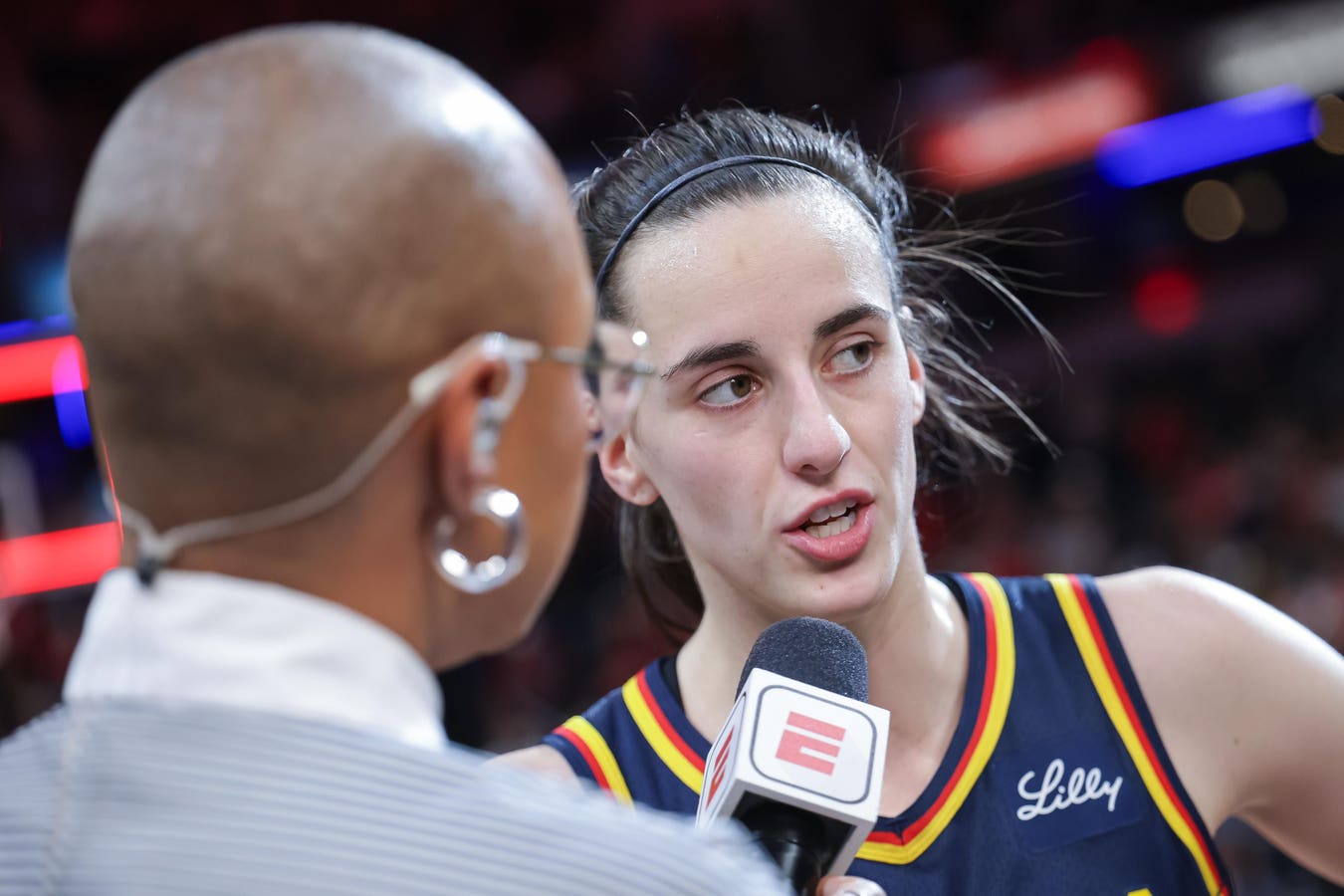INDIANAPOLIS, INDIANA – JUNE 14: Caitlin Clark #22 of the Indiana Fever talks with ESPN reporter … More
Contrary to the dominant narrative, Caitlin Clark did not singlehandedly launch women’s sports into the national spotlight. The sharp rise in WNBA viewership, sponsorships, and fandom is not the result of one breakout player, but the outcome of decades of advocacy, standout athletes, and loyal fanbases. Following Clark’s recent injury absence and inconsistent game appearances between May 24 and July 9, public scrutiny around WNBA viewership totals began to surge. Some used the temporary dip in ratings to argue that Clark alone is responsible for the league’s success. But this narrative misses the mark. The numbers actually reveal that viewership is not reliant on one player, but instead that when WNBA games are scheduled in accessible time slots on widely available networks, viewers show up in (often) record numbers.
The important storyline over those weeks is about untapped potential, not declining numbers. Rather than being a cause for concern, current viewership trends suggest a powerful opportunity for media entities. Simply put, the WNBA does not need saving or a single player to cary the viewership load. Instead, the league needs staging, because when women’s basketball is given the spotlight that it has come to earn, it frequently delivers.
MINNEAPOLIS, MINNESOTA – JULY 1: Kelsey Mitchell #0 of the Indiana Fever works around Courtney … More
2025 WNBA Time Slot Distribution Analysis
In television, especially for sporting events, primetime refers to the hours between 7:00 PM and 10:00 PM Eastern Time, when networks schedule their biggest games and shows to reach the largest audience. This window of time applies every day of the week and includes weekends. Games that start during this period are considered primetime because most viewers are home and available to watch live. In contrast, afternoon games, which typically fall between the hours of 1:00 PM and 4:00 PM ET, are not considered primetime slots, although they can at times draw strong audiences for certain fan demographics, particularly on weekends when more people have free time. Late-night games, starting around 9:30 PM ET or later, often see smaller viewership numbers since they air too late for fans on the East Coast.
Importantly, while primetime is certainly the sweet spot for TV audiences, the WNBA’s numbers provide evidence that there is untapped potential outside of those hours as well. Weekend afternoon slots, especially Saturdays, have pulled in very strong viewership and beat out traditional primetime game slots.
2025 WNBA Television Viewership Analysis (ET)
The data highlights an exciting opportunity for the WNBA and its media partners to unlock even greater growth. Weekend afternoon games between 1 and 3 PM regularly attract strong audiences. Notably, four of the five highest-rated games aired at 3 PM on Saturdays, averaging 2.16 million viewers, but this popular time slot represents less than a quarter of the national schedule. While only 25% of WNBA games currently air during the traditional primetime window of 7 to 9 PM ET, these slots are often on cable networks with more limited reach. As a result, the WNBA and media stakeholders should continue to meet fan and audience preferences where they are at in terms of preferred time slots and channels.
- May 17 (Sat, 3:00 PM, ABC) – Afternoon
Chicago Sky at Indiana Fever
Viewership: 2.7M (Peak: 3.1M)
Most-watched regular season game since 2000 - May 24 (Sat, 3:00 PM, ABC) – Afternoon
New York Liberty at Indiana Fever
Viewership: 2.22M (Peak: 3.24M)
8th largest WNBA audience since 2001 - June 14 (Sat, 3:00 PM, ABC) – Afternoon
New York Liberty at Indiana Fever
Viewership: 2.20M (Peak: 2.8M)
Clark’s return from injury - June 7 (Sat, 3:00 PM, CBS) – Afternoon
Indiana Fever at Chicago Sky
Viewership: 1.92M
Clark injured – still drew 1.9M+ - June 22 (Sun, 3:00 PM, ESPN) – Afternoon
Indiana Fever at Las Vegas Aces
Viewership: 1.7M (Peak: 2.2M)
ESPN’s 3rd largest regular season audience - May 17 (Sat, 1:00 PM, ABC) – Afternoon
Las Vegas Aces at New York Liberty
Viewership: 1.3M (Peak: 1.9M)
Opening weekend doubleheader - May 4 (Sun, 4:00 PM, ESPN) – Afternoon
Indiana Fever vs Brazil (Preseason)
Viewership: 1.3M (Peak: 1.6M)
Preseason game at Iowa - July 8 (Tue, 7:00 PM, ESPN) – Primetime
Las Vegas Aces at New York Liberty
Viewership: 701K (Peak 813K)
Most-watched non-Indiana WNBA game on ESPN (E1) since 1999 - June 17 (Tue, 8:00 PM, NBA TV) – Primetime (Cable)
Connecticut Sun at Indiana Fever
Viewership: 624K
NBA TV’s best of 2025 season - May 16 (Fri, 7:30 PM, ION) – Primetime
Minnesota Lynx at Dallas Wings
Viewership: 612K
121% increase from same time-slot last season - May 16 (Fri, 10:00 PM, ION) – Late Night
Los Angeles Sparks at Golden State Valkyries
Viewership: 581K - May 28 (Wed, 7:30 PM, NBA TV) – Primetime
Indiana Fever at Washington Mystics
Viewership: 357K
SAN FRANCISCO, CALIFORNIA – MAY 06: Kaitlyn Chen #2 of the Golden State Valkyries reacts after … More
The previous viewership data also shows that broadcast networks like ABC, CBS, and ESPN can significantly boost viewership. The WNBA has already proven it can attract NFL-level audiences when given the right platform and promotion and by continuing to collaborate closely with media organizations to secure more weekend afternoon and primetime slots on major broadcast networks, the league and its partners can tap into an even larger audience. Shifting just half of the games to primetime on ABC or CBS could increase average viewership from around one million to between 1.5 and 2 million per game, making this a promising path for future growth.




